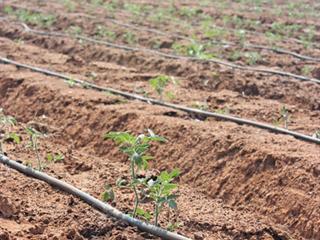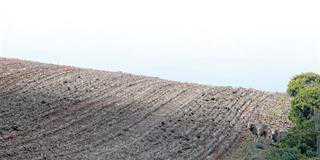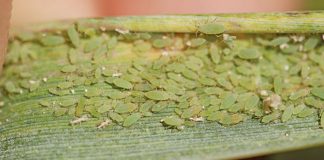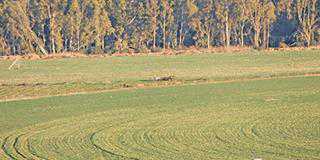
Petrus van der Walt’s farm in Koedoesrand, Limpopo, is managed with one goal in mind: sustainability for the next generation. He maintains that if a farmer can successfully bring his children into the enterprise, he has achieved something significant.
“It’s good to be able to offer my children a future on the farm. If it weren’t for them, I wouldn’t have carried on farming,” he says simply.
Petrus and his wife Hannelie have three children: Jakomien (27), Andries (25) and Hendrik (21). Jakomien’s husband Johan Roos and Andries’s wife Eljana are also involved on the farm. Petrus is the third generation on Boulust and is intent on keeping it in the family. His grandfather bought the farm in 1920, and Petrus has expanded it from its original 1 400ha to 3 500ha by buying adjoining farms from his uncles.
A full cycle
An efficient rotation cycle ensures that Petrus either harvests or plants in any month year-round. He plants 35ha to tobacco from August to December, which yields about 3,2t/ha. After being picked, it is air-dried in three sheds and delivered to Fox Tobacco, which sources 60% of its supply from Petrus.
“Tobacco needs a lot of heat and that we have. It’s all we can plant in summer. Because of our distance to the Gauteng markets we can’t compete with the Brits vegetable farmers in summer. But in winter we can because we don’t get any frost and the vegetable stock at the markets is low,” explains Petrus.
In January and February he plants 30ha to jam tomatoes to be harvested in April. Half of the crop is sent to Tiger Brands to be canned or used in tomato paste. Petrus has had a contract with Tiger Brands for 10 years which has brought stability to his enterprise, particularly as there is an annual price increase. The other half of the tomatoes and the rest of the vegetables are sent to the Johannesburg Fresh Produce Market (JFPM).
In February he plants 5ha to butternut and 31ha to onions, to be harvested from July to September. In March he plants 8ha to table tomatoes to be harvested in June, and in May he plants Crown Prince pumpkins to be harvested in October and November. In the same month, he also plants 10ha of watermelon to be harvested in October to December.
As the capacity of the Tshwane Fresh Produce Market has declined, Petrus prefers to send his produce to JFPM, adding R1 000 per trip to his transport expenses. “Sending produce to the market is a gamble. Sometimes, the prices are low, at other times they’re high. But this keeps farming interesting,” he chuckles.
Although his production is highly diversified, Petrus maintains that management is easy as the routine is repeated. The onion and some of the tomato production is handled by his sons. He explains that as Tiger Brands does not give out new contracts readily, his sons have to be involved with the tomatoes so the contract can be passed to them when he retires.
Sustainability
Boreholes provide water on the farm but Petrus uses only 30% of each hole’s capacity. “If you over-use it, you lose it,” he says. “Some boreholes on the farm have been going for 30 years.” All the crops, except for the onions, are drip-irrigated. The onions are under sprinkler irrigation and watered at night to minimise evaporation and save electricity.
Petrus protects the environment as far as possible and maintains a 50:50 ratio of fish-based organic fertiliser and chemical fertiliser. Supplements are added according to soil analysis, which is conducted before planting tomatoes and tobacco. “Tobacco has a high fertiliser requirement but after it’s harvested, the residual fertiliser is still sufficient for the following pumpkin crop on the same land,” he explains.
Petrus has established a convenient routine to ensure a steady supply of chicken manure. His truck collects it from chicken farms in Polokwane every time it returns from delivering vegetables to the market. The manure is added to the land at 200kg/ha. Once a week, a consultant examines the crops to determine what pest control, if any, is needed. Regulations are a difficulty. “The stuff you sprayed last year may not be permitted this year.
Without an expert, you can get problems at the market,” says Petrus. But tomatoes always require fungus and insect control. “If you don’t spray them, you don’t get a harvest,” he admits. Petrus runs a five-year rotation of vegetables and fodder sorghum. The latter is baled for dry years and his fodder bank currently has over a thousand 1,5m bales.
About 8ha of maize is also planted to add to this bank. Petrus remains positive about his profession, saying, “There’s still a living to be made out of farming in Limpopo. If there weren’t, I wouldn’t be doing it.”
Climate Change
Petrus has noted significant climate change during the past few years. “Our winters are getting colder, with an increasing incidence of frost on the farm’s lower-lying lands. We’ve had to move our vegetables to higher-lying lands,” he says. “It also means I’ve had to think more carefully when I plant. I can’t change my season because harvesting in winter is the only reason why I obtain such good prices for my vegetables.”
Zimbabwean Labour
About 100 permanent workers live on the farm. About 80% of these are Zimbabweans because, as Petrus explains, the risk is lower than with employing South Africans. “The Green Paper [on Land Reform] makes employing locals very risky as they could lay claim to my land. With Zimbabweans there’s no such risk,” he says.
But employing foreigners has its own problems. “Applying for work permits and passports for Zimbabweans is expensive and takes time,” he explains. “About 10% leave once they have their documents and their first pay cheque to go to Johannesburg. But that is a risk I have to take.”
Livestock Component
Petrus runs 200 Bonsmara cows and seven Bonsmara bulls for weaner production. This is managed jointly by Petrus and his sons. The cows have a 75% calving rate as the mating season is only from January to March. Petrus replaces two bulls every two years, buying replacement bulls from breeders and at auctions in the Vaalwater area to ensure a pure bloodline.
“If my herd produces a good-looking bull I will keep it to breed with. Otherwise, the weaners are sold to feedlots in the district.”
Petrus is fortunate to have a large flock of oxpeckers in the area and so has to dip his cattle only once a year – and only if there has been plenty of rain and the ticks become too abundant for the birds.
About 50 birds per 60 head of cattle are ideal. “There is a fine line between having too many birds and having too few,” he says. “If there are too many, they can harm the cattle by pecking their ears till they bleed. Unfortunately, it’s impossible to control the number.” The cattle graze on sweetveld during years when rainfall has been high.
Supplementing farm income
Petrus has branched into game to supplement the farm’s income, as hunting is popular in winter in the area. Boulust has a 65ha camp which includes about 100 nyala, 120 kudu and 250 impala. There is also a single male kudu with a white gene that Petrus is trying to breed with.
“The females have been producing white offspring but we don’t know which male kudu has the gene, so for now the kudus aren’t hunted,” he says. To complement the game on the farm, Petrus keeps a flock of 250 Persian x Dorper sheep. “The high fat content of the carcass is in high demand by game hunters for making game wors,” he explains.
Contact Petrus van der Walt at [email protected]













